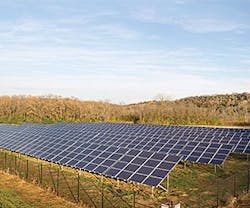Small Colleges Take Big Energy Steps
Small schools with ostensibly smaller resources are making large strides by seizing support from various partners and pledging sustainability commitments.
To get a wind power project off the ground, Luther College in Decorah, IA, formed a for-profit arm of the school, the Luther College Wind Energy Project LLC, with the corporation owning the turbine and Luther acting as sole investor. Conversely, Luther leases solar equipment on their campus grounds from a local company, the Decorah Solar Field LLC, without having to provide the necessary capital.
The 1.6 mW turbine was installed last fall. The 280 kW solar field powers a student housing complex that uses geothermal energy to heat and cool the facility.
“We’ve married a technology associated with energy efficiency to a renewable energy technology to show it’s possible to live off the sun,” says Professor Jim Martin-Shramm, chair of the energy and water task group of the sustainability council.
In 2004, the college invested $1.5 million in retrofits that cut energy consumption by 23% over 18 months and yielded a seven-year payback. Luther joined the American College and University Presidents’ Climate Commitment (ACUPCC) in 2007, aiming to cut its carbon footprint in half by 2015 and become neutral by 2030.
Another ACUPCC charter signatory, Allegheny College in Meadville, PA, has vowed to reach similar goals.
“We performed an energy audit in 2000 and retrofitted facilities in conjunction with the local medical center, allowing the two entities to hire the auditing company together and pool our fixtures orders in bulk for better prices,” explains Kelly Boulton, sustainability coordinator at the college.
Retrofits to the insulation and HVAC systems, along with solar panels on two buildings, have helped the college reduce annual energy costs. The more efficient lighting and water fixture retrofits paid for themselves quickly, convincing the college to invest more.
“Now energy efficiency is a standard component incorporated into the annual budget. Since 2008 we’ve invested $2 million in it,” Boulton explains.
